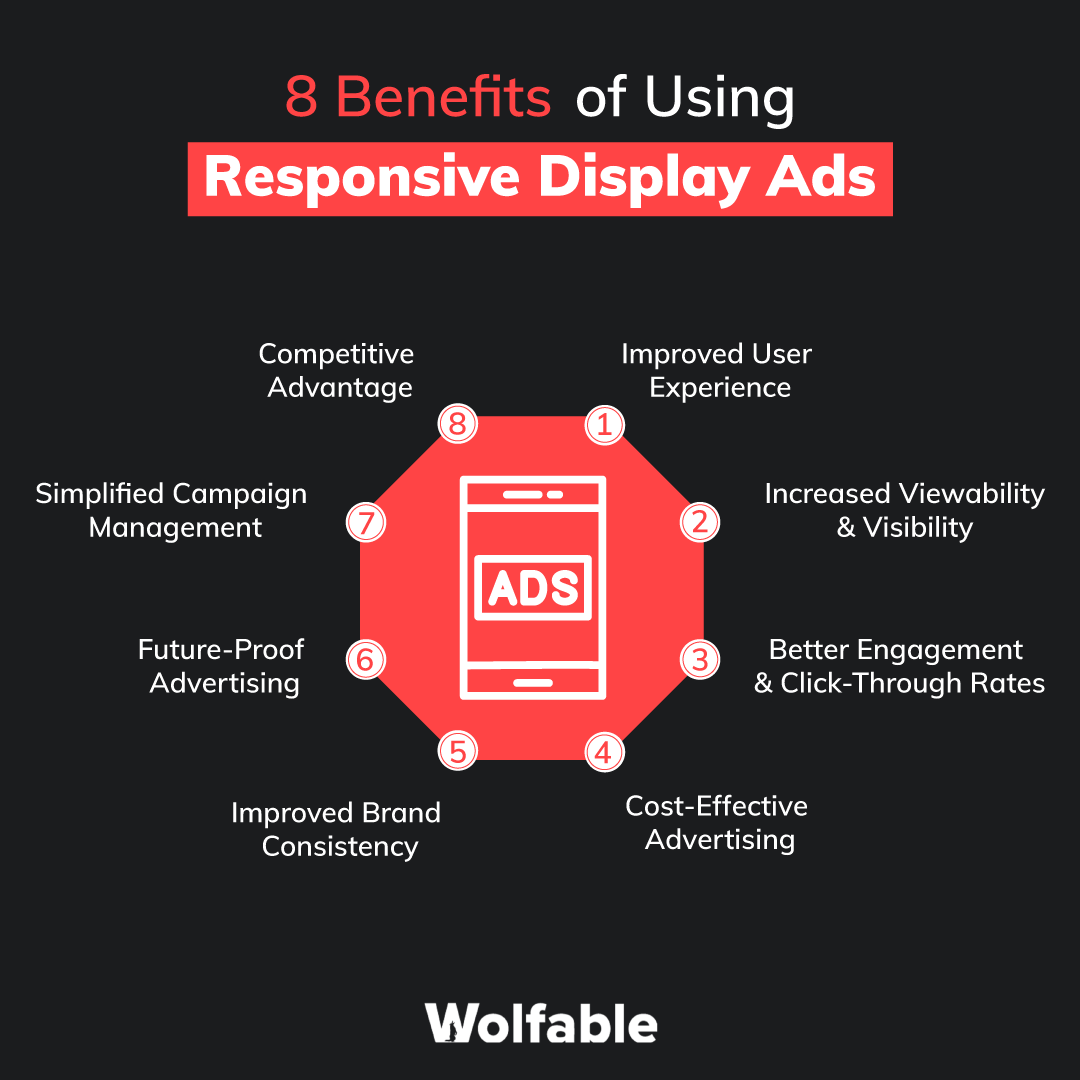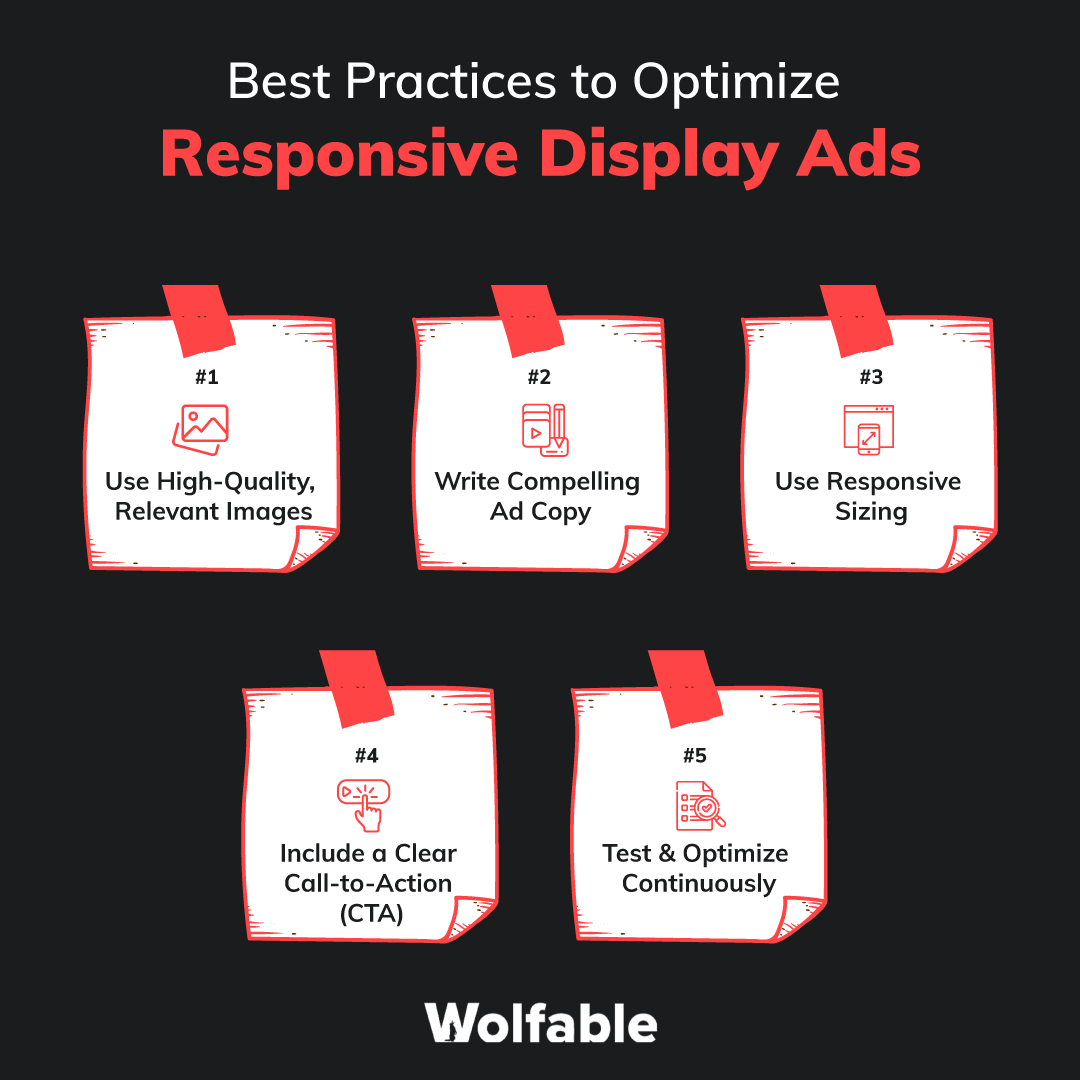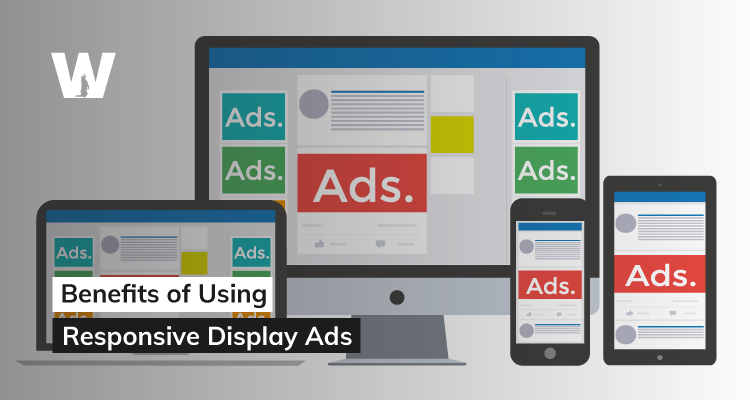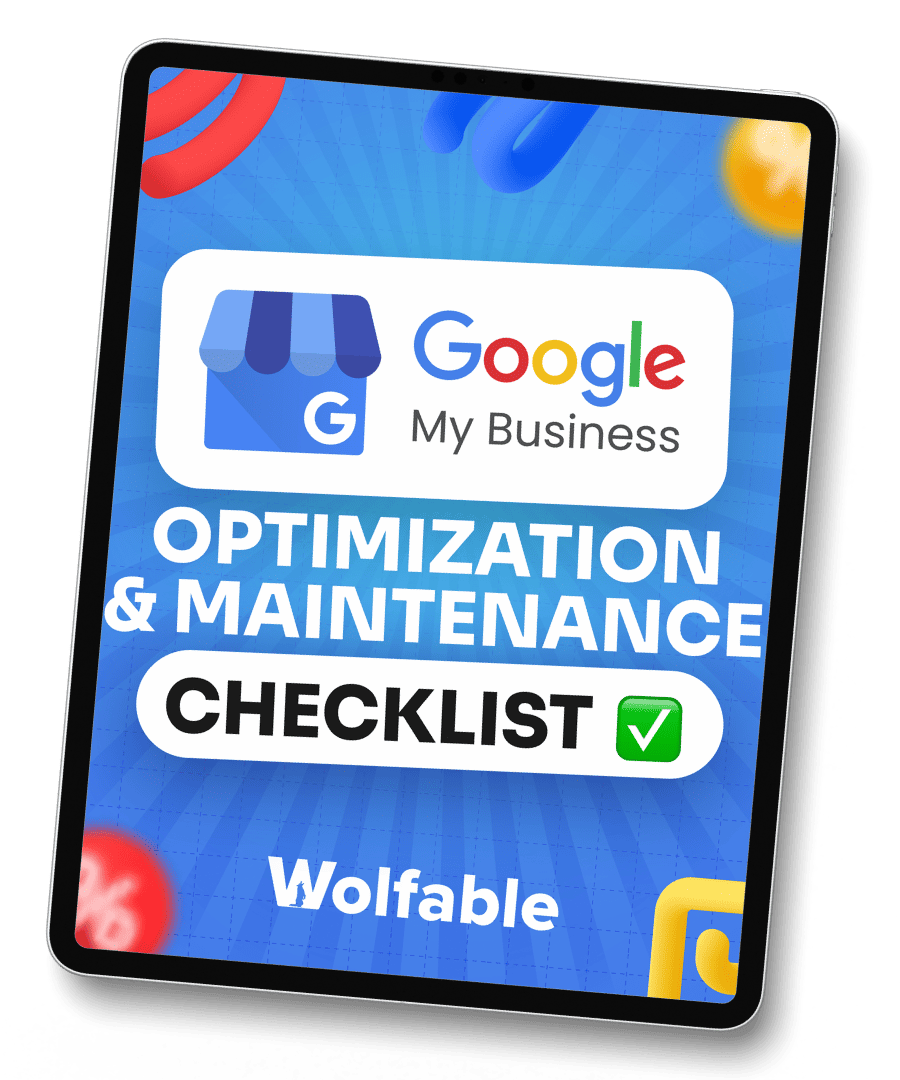Wraps up in 15 Minutes
Visual advertising has become increasingly effective in capturing the attention of your target audience, especially in 2024.
But with so many different kinds of devices and screen sizes out there, it's crucial to ensure that your ads look stunning and engaging no matter where they're displayed.
Thankfully, this is where responsive display ads come to the rescue.
In this post, we will talk about responsive display ads in detail, including the definition and benefits, and step-by-step process.
What are Responsive Display Ads?
Responsive display ads are a type of ad format that automatically adjusts its size, layout, and appearance to fit seamlessly across various devices and screen resolutions.
Unlike static display ads, which are designed for a specific size, responsive display ads adapt themselves to ensure a consistent and optimal viewing experience, whether viewed on a desktop, laptop, tablet, or smartphone.
This adaptability is achieved through the use of responsive web design principles, which allow the ad's elements (such as images, text, and calls-to-action) to dynamically rearrange and resize based on the device's screen size and resolution.
This, in turn, helps to ensure that your target audience has a seamless and user-friendly experience, no matter how or where they are viewing your ad.
In other words, responsive display ads are a game-changer because they eliminate the need to create multiple static ad sizes for different devices and placements. Instead, you just need to create a single responsive ad unit that will adapt and serve the most appropriate version for each situation.
8 Benefits of Using Responsive Display Ads

Now that you know what responsive display ads exactly are, let’s talk about the 8 main benefits of using them for your business.
1. Improved User Experience
As mentioned in the beginning, people nowadays use a wide variety of devices to access the internet and consume content — smartphones, tablets, laptops, desktops, and more.
The screens on these devices come in various sizes, and they have different levels of detail and clarity. And creating an optimal user experience across all these devices can be a real challenge for advertisers.
Responsive display ads solve this problem by dynamically adjusting their layout, formatting, and assets to provide a seamless, native experience tailored to each device's screen size and resolution.
The text automatically resizes for easy reading, images are optimized and cropped intelligently, and the content flows in a way that looks natural on any viewport.
This level of user-friendly optimization creates a smooth, friction-free ad experience that keeps your target audience engaged and attentive. They can easily read, understand, and interact with the ad content without wrestling with pinch-to-zoom or squinting at tiny text.
2. Increased Viewability and Visibility
Viewability is a key metric in visual advertising. For the uninitiated, it basically measures how many times your ad has had the opportunity to be seen.
If your ad doesn't render properly on a device, its viewability plummets. And poor viewability translates to wasted ad spend and reduced ROI.
Traditional static ads often display poorly on mobile screens — getting cut off, overflowing their containers, or failing to resize assets properly. This makes them less visually appealing and noticeable to people.
In contrast, responsive ads are meticulously optimized to be perfectly visible on any screen size or resolution. The entire ad and all its key messaging are guaranteed to render flawlessly every time, without any elements getting obscured or distorted.
This enhanced viewability boosts an ad's chances of catching a user's eye and commanding their attention.
When ads are eye-catching and visually coherent, people are more likely to actually perceive and engage with them.
3. Better Engagement and Click-Through Rates
Building on improved viewability, responsive ads greatly enhance engagement levels too.
When ads provide a smooth, visually appealing user experience tailored to each device, people are much more likely to engage with the content.
User-friendly responsive formatting makes ads easier and more enjoyable to consume.
The content flows naturally, the images look sharp, and the text is readable without strain. This frictionless experience encourages users to fully take in the ad instead of bouncing away in frustration.
With longer, more attentive engagement, people have more time to digest an ad's key messaging and call to action.
This increased comprehension and positive brand perception makes people more prone to click-through and convert.
4. Cost-Effective Advertising
From a production standpoint, responsive ads offer significant cost savings over traditional display ad campaigns.
Instead of having to create multiple static-sized ads for different device types and resolutions, a single responsive ad can cover all your bases.
Without responsive design, advertisers have to build out distinct ads for common resolutions like 300x250, 320x50, 728x90, etc. This redundant versioning process multiplies production costs in terms of design hours, developer resources, and project management overhead.
With responsive ads, a single build can automatically render perfectly across device types, viewports, pixel densities, and more. This consolidated, standardized approach streamlines production and slashes costs by reducing the number of individual ad units that need to be designed, built, tested, trafficked, and maintained.
5. Improved Brand Consistency
Maintaining a consistent brand image across all platforms is crucial for building recognition and trust with your target audience.
Using traditional static display ads often forces brands to present different visuals, formatting, and messaging depending on the device a user is viewing the ad from.
On the other hand, responsive display ads ensure that your branding elements (logo, colors, and messaging) are displayed consistently, regardless of the device being used.
This consistency in presentation reinforces key branding volleys like color associations, logo iconography, and distinctive ad copy phrasing.
6. Future-Proof Advertising
Technology is evolving at a breakneck speed, with dozens of new devices hitting the market every year.
Just think about how much smartphones, tablets, laptops, and desktops have changed over the last three years.
For advertisers, this constant device fragmentation creates a huge headache when it comes to ensuring ads display properly everywhere.
With traditional static ad formats, you'd have to constantly create new sizing variations to account for every new screen dimension that emerges.
This redundant, reactive workflow is incredibly inefficient and costly. By the time you've built out ads for the latest devices, new ones have already been released, restarting the cycle. It's an endless game of catch-up.
Responsive display ads break this cycle by using flexible, device-agnostic design principles. Instead of targeting specific resolutions, they fluidly adapt their layouts, assets, and formatting to render perfectly on any present or future screen size.
This future-proof capability provides immense time and cost savings over static ads.
You aren't trapped in a perpetual cycle of revisions and rebuilds. A single responsive ad can stay effective and relevant for years, eliminating tedious rework and allowing you to reallocate those resources elsewhere.
7. Simplified Campaign Management
Managing a full-funnel digital ad campaign already requires juggling many different components, channels, creatives, audiences, and more.
Traditional static ads only compound this complexity by forcing advertisers to create, traffic, monitor, and optimize distinct ad units for every potential device and size configuration.
This fragmented, multi-sized ad approach exponentially increases operational overhead and cognitive load.
Thankfully, responsive display ads can simplify this entire process down to a singular, standardized workflow. With just one responsive ad unit serving all your sizing needs, you can streamline absolutely every facet of campaign operations.
The simplified processes and consolidated intelligence allow for smarter, more efficient, and more agile campaign management.
The best part? — You can focus more time on strategic optimization and creative experimentation rather than wrestling with logistical busywork.
8. Competitive Advantage
The visual advertising industry is extremely crowded and competitive across nearly every product category and industry vertical.
Brands are constantly fighting for the limited attention of audiences who are oversaturated with ads around every digital corner.
Given such extreme competition, simply having ads appear is no longer enough to stand out and drive impact. The quality, usability, and relevance of the ad experience itself are what separates unmemorable ads from those that connect and compel action.
But, if you leverage responsive display ads, you need to immediately differentiate your brand through the premium cross-device creative experience they can provide.
In other words, you need to position your brand as innovative and audience-centric, prioritizing quality creative, and seamless digital experiences.
Beyond just stature and perception benefits, fully responsive ads actively encourage deeper engagement by removing all usability friction and contextual disruptions. This enhanced engagement drives improved metrics like viewability, brand recall, click-throughs, and ultimately, conversions.
When to Use Responsive Display Ads?
Responsive display ads are a versatile advertising solution that can be employed in various scenarios:
Multi-device Advertising Campaigns
If you're trying to reach audiences across this wide range of gadgets, responsive ads are the way to go.
Instead of creating separate ads for each device type, a single responsive ad automatically adjusts to look perfect on any screen size. This ensures a smooth, consistent experience for all your viewers, whether they're on a tiny iPhone or a huge desktop monitor.
Reaching a Diverse Audience
Let's say your target customers are a diverse bunch that accesses the internet through various devices and platforms.
Young people might primarily use social media on their phones, while older folks browse websites on tablets or computers.
With responsive display ads, you can effectively connect with all these different audience segments in one fell swoop. No matter what device they're using, your ad will look great and function flawlessly.
Promoting Brand Awareness
Building a strong, recognizable brand is crucial for businesses.
You want your logo, color scheme, and overall look to be consistently on-point whenever someone engages with your marketing.
Responsive ads ensure this unified branding experience across all devices and platforms. Your visuals, messaging, and identity will look sharp and on-brand every time, strengthening your credibility with potential customers.
Driving Traffic and Conversions
Responsive ads don't just look good – they actively encourage people to engage and take action!
Since the ads provide such a smooth, user-friendly experience on any device, viewers are much more likely to actually read the content, click through, and hopefully convert leads or sales for your business.
The high-quality, seamless ad experience directly translates into better performance metrics.
How to Create Effective Responsive Display Ads? — Step-by-Step Process
Creating an effective display ad that responds well across various devices and platforms involves several key steps.
Here’s a step-by-step process to guide you through creating responsive display ads that not only look good but also perform well:
Step 1. Define clear advertising goals and objectives
Before you begin your ad creation, it’s vital to take a step back and get crystal clear on exactly what you’re trying to achieve with responsive display ads.
- Are you looking to boost brand awareness and get your name out there?
- Trying to drive more traffic to your website?
- Or are you ultimately aiming for more sales and conversions?
Defining your responsive display ad goals from the start will help guide the entire ad development process and ensure your ads are purposefully designed to deliver the right results.
Step 2. Understand your target audience
Audience research should be an essential first step for any ad campaign. The more intimately you understand your prospects, the more relevantly you can market to them.
This is because you can’t create ads that truly connect until you intimately understand who you're trying to reach.
So, you need to conduct thorough research, dig into your target audience demographics, and study how they typically consume media and marketing across various screens and channels.
- Where do they spend time online?
- What devices do they use?
- What type of messaging and visuals tend to resonate best?
Getting a 360-degree view of your audience will allow you to craft ads specifically tailored to grab their attention and align with their preferences.
Step 3. Choose the right ad format and layout
Once you understand your audience and goals, you can hone in on the ideal ad format, layout, and delivery channels to reach users at the right times and contexts.
Static image and GIF ads are versatile and load quickly but offer limited interactivity and storytelling potential. Video ads are highly engaging but more resource-intensive. HTML5 ads strike a balance with lighter file weights than videos but more dynamic, interactive capabilities.
For layouts, you'll want to carefully map your creative messaging strategy to physical ad dimensions and UI elements.
In other words, you should play with different layout options to see what looks visually striking while giving your content room to breathe.
The format and layout you choose should serve the creative rather than cramping your style.
Step 4. Incorporate engaging visuals and compelling copy
Even the most responsive ad experience won't matter if your creative isn't engaging and motivating.
For maximum results, you need to invest heavily in visual design and smart, persuasive copywriting.
On the visual side, you need eye-catching creative that instantly hooks viewers and reinforces your brand's identity. If it makes sense for your campaign, even investing in high-quality video footage can pay off by capturing attention in impactful ways.
But visuals alone won't cut it - your written copy has to be on point too. What I mean by that is you need to use a lean writing style to clearly spell out the key benefits through emotion and logic.
And of course, include clear calls-to-action that create a sense of urgency and guide prospects directly toward your desired outcome.
Most importantly, the visuals and writing need to merge into one cohesive, motivating story that both educates and persuades your audience.
Step 5. Test and refine ads before launch
With responsive advertising, testing is even more critical, as you're ensuring flawless ad delivery and functionality across countless device/OS/browser/connectivity permutations.
To conduct a thorough test, we recommend using cross-platform browser tools like BrowserStack to test your ads across real desktop, mobile, and tablet environments — not just device emulators.
Additionally, it's also important to check how your ads perform. For instance, you need to look at how fast they load, how smooth they run, how big the files are, and how much computer power they use.
If required, you must try to make your files smaller using the latest compression methods and test how they perform on unstable internet connections.
Remember, even small changes can make your ads work much better and give your audience a better ad experience.
Best Practices to Optimize Responsive Display Ads

Creating captivating responsive display ads is just the first step in your advertising journey.
If you want to drive tangible results, ongoing optimization is key.
Here are some best practices our experts follow to optimize your responsive display ads and help you achieve your advertising goals:
Best Practice #1. Use High-Quality, Relevant Images
Let's face it - Nowadays, people have short attention spans. That means you’ve just a few seconds to catch someone's eye with your display ad. That's why using high-quality, vibrant visuals is so crucial.
If you use blurry, pixelated, or low-res images, your ad will look sketchy and unprofessional. For this reason, you must opt for high-resolution photos or graphics that instantly grab attention.
But don't just choose any old striking image – it needs to be highly relevant to what you're advertising. The image you choose should reinforce your ad's message and give viewers an instant visual cue about what your product or service is all about.
Best Practice #2. Write Compelling Ad Copy
While an attractive visual will get people to initially notice your ad, it's the written content that's going to seal the deal and convince them to take action.
You just have a headline and a short descriptor space to work with, so you need to make those words count!
This is why we recommend starting with a punchy, benefit-driven headline that highlights the key value your product or service provides. Instead of just stating what you're selling, speak directly to your target audience's desires or pain points.
For example, rather than "Weight Loss Supplements," go with something like "Finally Shed Those Stubborn Pounds."
Then, in the descriptor text, expand on that core benefit and use persuasive, conversational language to give folks a clear reason to click.
Remember, this part is about building desire and giving people that extra nudge toward checking out your offering.
Best Practice #3. Use Responsive Sizing
These days, people are jumping between their phones, tablets, laptops, and desktop computers more than ever before.
That's why responsive sizing is an absolute must for display ads – it ensures your creative looks fabulous and fits perfectly no matter what device someone is using.
For the uninitiated, responsive ads automatically adjust their dimensions to fit available ad spaces of varying sizes and aspect ratios. That means, your ad will just seamlessly adapt and look great across screens big and small.
To take full advantage of this flexibility, just be sure to follow the recommended aspect ratio and sizing specs for whichever platform you're advertising on. That way, your image and text elements will display properly in any ad slot.
Best Practice #4. Include a Clear Call-to-Action (CTA)
So, you've grabbed someone's attention with an eye-catching visual, and your compelling ad copy has them seriously intrigued about your product or service.
Now, it’s time to seal the deal with a clear, hard-hitting call-to-action (CTA). In fact, your CTA is quite literally a "call" that tells the viewer exactly what action you want them to take.
This is why your CTA should be short, and snappy, and use persuasive language that creates a sense of urgency and motivation. Simple CTAs like "Buy Now," "Get Started Today," or "Learn More" are super effective.
Furthermore, you need to make sure that your CTA really pops by using a contrasting color, button, or other design element. And of course, align that CTA text with the overall goal of your ad campaign – if you want sales, use a purchase-oriented call.
Best Practice #5. Test & Optimize Continuously
Even if you create an absolute masterpiece of a responsive display ad, the work isn't over.
Consumer behaviors and preferences are constantly evolving, so what works amazingly well today might fall flat in a few months. That's why you need to embrace ongoing testing and optimization as standard practice.
To do this effectively, the first step is to set up your campaigns to rotate multiple versions of your ad creative.
This allows you to run controlled tests and gather data on how different visuals, copy approaches, CTAs, and so on impact important metrics like click-through rates, conversion rates, and costs.
Conclusion
Responsive display ads offer a powerful solution that not only elevates your advertising efforts but also delivers a superior user experience across devices.
At Wolfable , we understand the importance of leveraging the latest advertising technologies to drive tangible results for our clients. Our team of experts specializes in creating and optimizing responsive display ads that not only captivate audiences but also seamlessly adapt to their preferred devices.
With our data-driven approach and deep understanding of responsive web design principles, we craft visually stunning and highly effective ads that resonate with your target audience.









